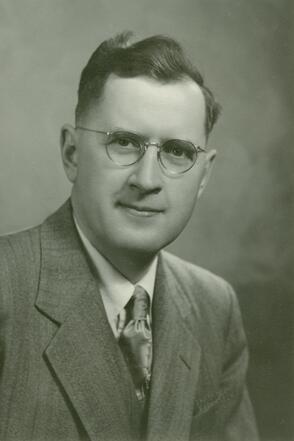
Title and statement of responsibility area
Titel
Dr. Harold E. Johns - Portrait
Algemene aanduiding van het materiaal
- Graphic material
Parallelle titel
Overige titelinformatie
Title statements of responsibility
Titel aantekeningen
Beschrijvingsniveau
Stuk
archiefbewaarplaats
referentie code
Editie
Editie
Edition statement of responsibility
Class of material specific details area
Statement of scale (cartographic)
Statement of projection (cartographic)
Statement of coordinates (cartographic)
Statement of scale (architectural)
Issuing jurisdiction and denomination (philatelic)
Datering archiefvorming
Datum(s)
-
[ca. 1948] (Vervaardig)
Fysieke beschrijving
Fysieke beschrijving
1 photograph : b&w
Publisher's series area
Title proper of publisher's series
Parallel titles of publisher's series
Other title information of publisher's series
Statement of responsibility relating to publisher's series
Numbering within publisher's series
Note on publisher's series
Archivistische beschrijving
Naam van de archiefvormer
Geschiedenis beheer
Bereik en inhoud
Head and shoulders image of Dr. Harold E. Johns, professor of Physics from 1945-1956.
Bio/Historical Note: Dr. Harold Elford Johns was, perhaps, the most influential medical physicist in Canadian history. He was born in 1915 in West China where his parents were educational missionaries. After the family returned to Canada in 1926, Dr. Johns obtained an MA in Physics from McMaster University and a PhD from the University of Toronto. He worked first at the University of Alberta in Edmonton and then at the University of Saskatchewan (1945-1956), where he became interested in cancer treatment. In May 1948 Drs. Johns, Newton Haslam and Leon Katz, all Physics faculty, travelled to Milwaukee to inspect the betatron that had been built for Saskatchewan. In August of that same year, the U of S installed in the Physics Annex the first betatron in Canada - the world’s first betatron used for a cancer treatment program. Dr. Johns then began the design and construction of one of the first cobalt-60 teletherapy units. In 1951 Dr. Johns and his graduate students became the first researchers in the world to successfully treat a cancer patient using cobalt-60 radiation therapy. In early 1952 Maclean's magazine had dubbed the cobalt-source radiotherapy machine the cobalt bomb - a tongue-in-cheek tribute to this peaceful use of nuclear technology. Dr. Johns’ pioneering work in cobalt-60 teletherapy became the gold standard for radiation therapy for many years and thousands of units were installed worldwide, helping countless patients. Working with Dr. Johns was Dr. Sylvia Fedoruk (1927-2012), part of the team of U of S scientists involved in the development of the cobalt-60 unit. The original treatment device was used in Saskatchewan until 1972. The work Dr. Johns and his team did on the physics of high energy photon beams was fundamental, and still forms the basis of most treatment planning systems in use today. In 1953 he published the first edition of “The Physics of Radiology” which became the leading textbook in its field for several decades. In 1956 Dr. Johns became head of the Physics Division of the Ontario Cancer Institute and professor of Medical Biophysics at the University of Toronto. For several years he studied the chemical processes that lead to radiation damage, and finally in the 1970s he turned his hand to x-ray imaging. All of Dr. Johns’ work was aimed at improving the diagnosis and treatment of cancer. The U of S awarded Dr. Johns an honourary Doctor of Laws degree in 1959. Harold Johns died in 1998.
Aantekeningen
Materiële staat
Directe bron van verwerving
Ordening
Taal van het materiaal
Schrift van het materiaal
Plaats van originelen
Beschikbaarheid in andere opslagformaten
Restrictions on access
Termen voor gebruik, reproductie en publicatie.
Photographer: Charmbury
Copyright holder: Unknown

